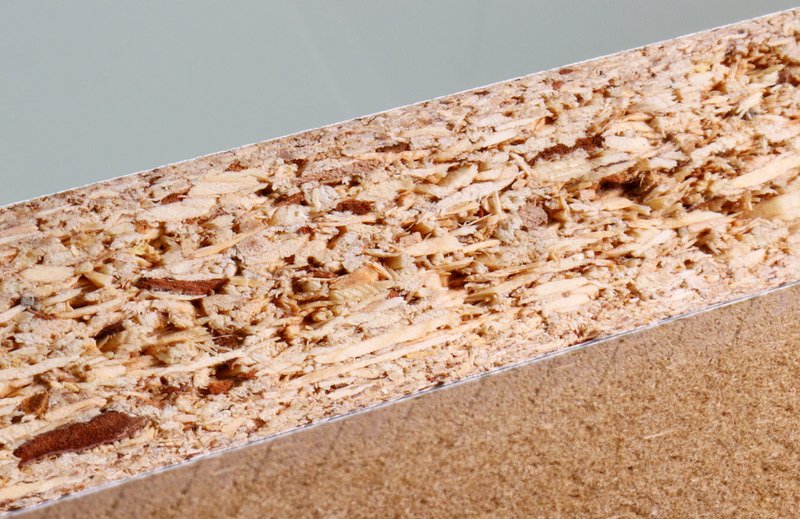Chipboard is a commonly used material for flooring projects — but why is it so popular?
This guide explains why chipboard is often used for flooring and shows you how to fit it in your home.
What Is Chipboard Flooring?
Chipboard is a wooden board made from wood chips, sawdust and other waste materials.
These materials are compressed under high pressure and stuck together with strong resin adhesive. It’s available in three densities: regular, medium and high.
You can use chipboard for multiple applications, but the high-density version is most commonly used in flooring.
It’s important to note that while chipboard looks similar to MDF, they have a crucial difference.
Chipboard contains a more significant amount of recycled wood chippings, which results in its unique cross-hatched look. In contrast, MDF is made almost exclusively from wood fibres, with a tiny amount of recycled material mixed in.
Chipboard is a little weaker and less durable than MDF for some applications. However, when it comes to flooring, high-density chipboard is an excellent choice for several reasons.
Why Is Chipboard Used For Flooring?

Below are the reasons why chipboard is an excellent flooring material:
Cost
As chipboard is made from woodchip and other recycled waste, it is a low-cost option that’s great if you’re on a tight budget.
Despite its low price tag, high-density chipboard is solid and durable because its wood chips and fibres don’t lay uniformly. This construction reduces the likelihood of splitting or warping over time.
Design
While you can use chipboard for other applications, it’s primarily designed for use as a flooring material. This singular focus means that it’s created and cut in an easy way to lay.
The best features of chipboard are its simple tongue and groove connectors, convenient panel sizes and a finished surface that makes it hassle-free to lay flooring on top.
Moisture Resistant Options
Chipboard flooring is available in moisture-resistant options, and the panels are usually green in colour.
When moisture-resistant chipboard is exposed to water or rain, it retains most of its strength and shape, unlike regular chipboard.
Remember that moisture resistance is not the same as “waterproof”. However, if you want to make your chipboard waterproof, there are ways to achieve this.
Grades
Chipboard is available in various grades, so there’s always something to meet your project requirements.
The best choice for domestic flooring is grade P5 or P7 if you need your floor to withstand heavy loads. These options are moisture-resistant and specially designed for flooring use.
How To Fit Chipboard Flooring — Step-by-Step Guide

The best way to fit chipboard flooring depends on the product you buy and the manufacturer’s instructions.
We’ve outlined a simple guide below explaining what to expect when installing your chipboard flooring.
1. Pre Installation Preparation
Before laying down your chipboard, it’s advisable to store boards for 48 hours in the room you’ll be fitting them.
This period allows the boards to become accustomed to the relative humidity and temperature of your room’s environment and shrink or swell accordingly before fitting.
2. Fitting Your Chipboard Flooring
You can begin the installation process once you have allowed the chipboards to acclimatise.
If you’re using chipboard panels with tongue and groove connectors, we recommend using an adhesive to secure them together. Run the long edges across the joists, and ensure the shorter sides end flush with the centre of the joists.
Apply a bead of adhesive along the noggins and joists where you’re laying the chipboard.
Place the chipboard panel down, and apply a screw to the tongue section at each joint. This step should secure the panel to the joist below it.
We strongly recommend leaving at least a 10mm gap between the screws and the edge of the panel and placing the screws 150mm from each side of the joist. This approach improves stability, provides room for any potential expansion and reduces the risk of a buckled floor should expansion occur.
Furthermore, we advise laying tongue and groove chipboard staggered, which helps evenly spread the weight across the supporting joists.
Final Thoughts
Chipboard is often used for flooring, offering homeowners a cheap, durable and easy-to-apply option.
Chipboard is available in various grades to suit your requirements, and you can also source moisture-resistant and waterproof options.
As you can see from our tips above, the application process is pretty straightforward, with only a small selection of tools required.
Considering all these factors, it’s no surprise that chipboard is a popular choice for flooring.
Check out our laminate and vinyl flooring cost guides for more flooring options.
FAQ
Below are answers to frequently asked questions about chipboard.
Why is chipboard commonly used for flooring?
Floor fitters commonly use chipboard flooring for a variety of reasons. It’s an inexpensive yet strong material, making it an attractive choice for those on a budget.
It’s easy to apply and comes in various grades to suit most requirements. You can also purchase moisture-resistant options to reduce the risk of warping and buckling over time.
What are the advantages of chipboard?
Chipboard is inexpensive, lightweight, easy to handle, simple to install and comes in various grades and specifications to suit most requirements.
What is stronger, chipboard or plywood?
Plywood is more robust than chipboard and has a cross-grain pattern that gives it greater strength.
Unlike chipboard made from wood chippings, sawdust and other wood pulp waste, plywood is constructed from several sheets of cross-laminated veneer wood and then sealed together with adhesive, high heat and pressure.
What are the disadvantages of chipboard?
Because chipboard is made from lots of separate pieces of material fused, it can be prone to splintering when driving nails and screws into it.
Also, if you don’t purchase a moisture-resistant grade, the chipboard will rapidly absorb any moisture it comes into contact with, potentially leading to swelling and warping.

